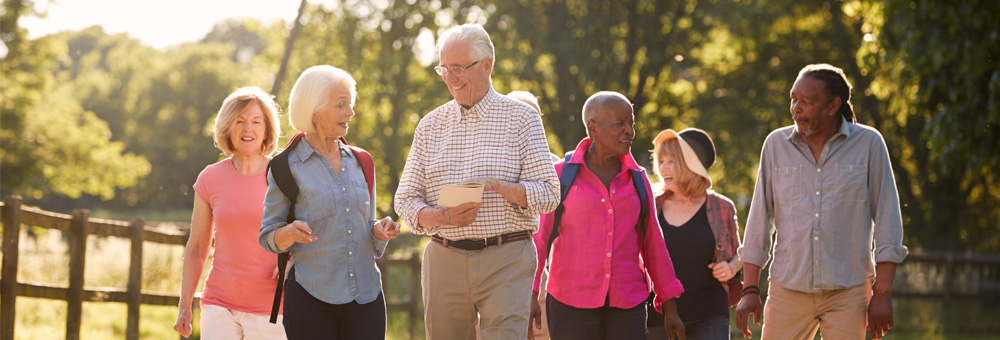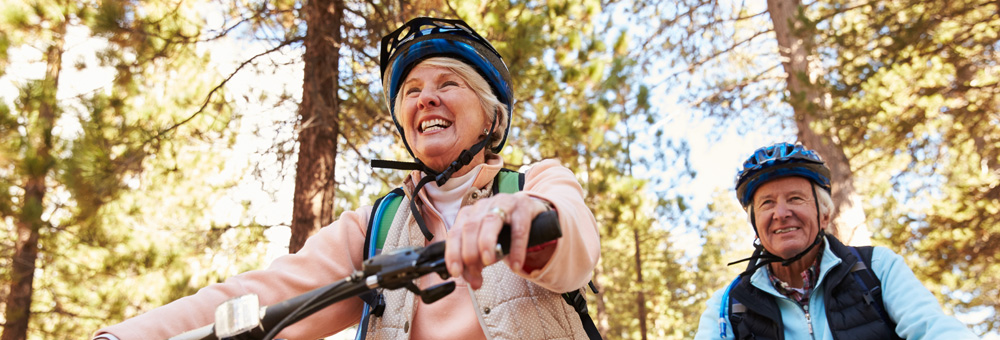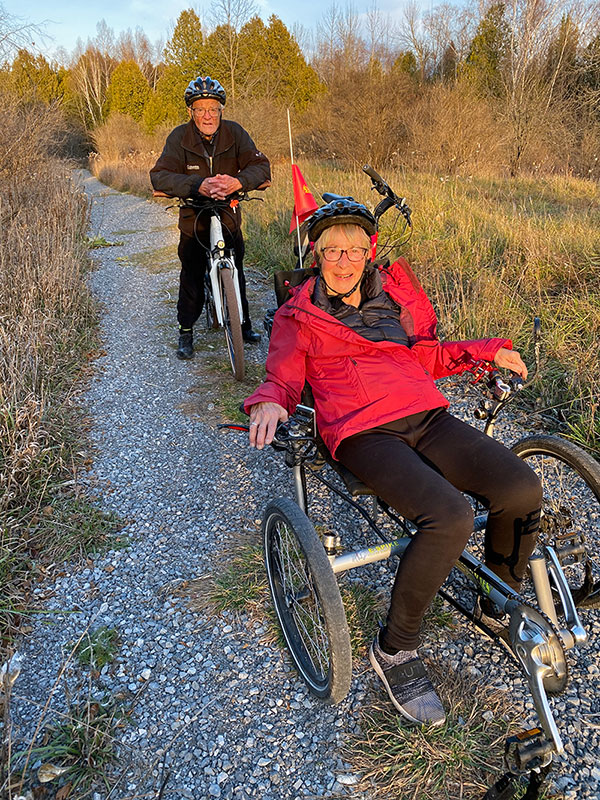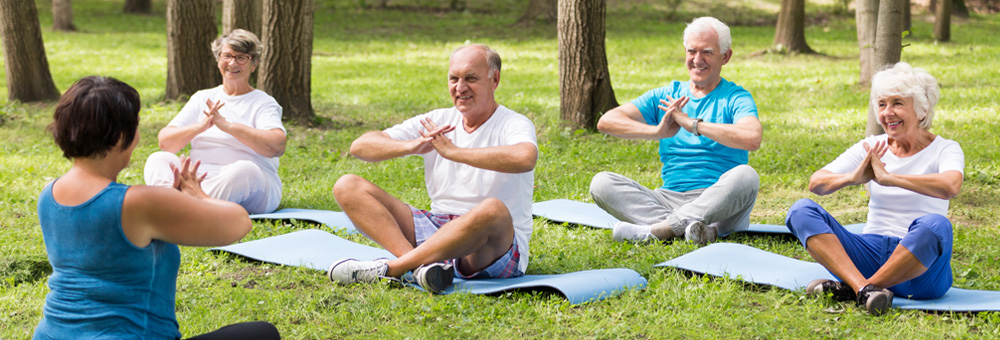Great Activities for Seniors
There is a wide range of activities available to seniors, including many that can be enjoyed outdoors along our beautiful trail system. But what activities are going to be most beneficial to older adults looking to improve their health and maintain independence?
In general, everyone’s fitness routines should be unique and tailored to their individual needs and abilities. Our recommended levels of physical activity applies to all adults aged 65 years and older who do not have a suspected or diagnosed medical condition. For these seniors, who are looking to maintain their overall quality of life through fitness, four areas of focus have been shown to be most important: endurance, strength, balance, and flexibility.
Endurance
Endurance exercises focus on your aerobic health. These exercises are designed to help increase your breathing and heart rate.
Walking / running
Gardening
Biking
Swimming
Dancing
Strength
Strength training is about working your major muscle groups. Muscles lose strength as we age, working them will help you remain mobile and active.
Using resistance bands
Body weight exercises
Hand weights or exercise machines
Balance
Performing activities to help maintain and improve your balance can make it easier to walk up and down stairs, and get around without suffering a fall.
Tai Chi
Yoga
Core strength exercises
Standing on one foot
Strengthening legs
Flexibility
Flexibility is about stretching, so that you can comfortably extend your range of motion when you need to reach, squat, or move around the house.
Yoga
Tai Chi
Focused breathing
Simple stretches
Light dancing
Water walking
There is no better place than the outdoors, either on the trail or off, to work on these four areas of physical fitness. Combining the benefits of spending time in nature with the appropriate physical activity will maximize the effects on your mental health, physical health, and overall well-being. Now, with the four areas of focus in mind, below is a sampling of some accessible and enjoyable activities for seniors to maintain and boost their physical activity, outdoors and in. Just be sure to consult a health professional if you are unsure about the types and amounts of physical activity most appropriate for you.
Click on any of the topics below to read more.

Walking
Improve Circulation
Walking wards off heart disease, brings up the heart rate, lowers blood pressure and strengthens the heart. Post-menopausal women who walk just 1-3 kilometres a day can lower their blood pressure by nearly 11 points in 24 weeks. Women who walk 30 minutes a day can reduce their risk of stroke by 20%, and by 40% when they stepped up the pace, according to researchers at the Harvard School of Public Health in Boston.
Strengthen Your Bones
Walking can stop the loss of bone mass for those with osteoporosis. In one study of post-menopausal women found that 30 minutes of walking each day reduced their risk of hip fractures by 40%.
Lighten Your Mood
Walking releases natural pain-killing endorphins to the body – one of the emotional benefits of exercise. A California State University, Long Beach, study showed that the more steps people took during the day, the better their moods were.
Strengthen Muscles & Lose Weight
Walking tones your leg and abdominal muscles, and even arm muscles if you pump them as you walk. A brisk 30-minute walk burns 200 calories. Over time, calories burned can lead to pounds dropped.
Improve Sleep
Studies found that women, ages 50 to 75, who took one-hour morning walks, were more likely to relieve insomnia than women who didn’t walk.
Support Your Joints
The majority of joint cartilage has no direct blood supply. It gets its nutrition from joint fluid that circulates as we move. Movement and compression from walking “squishes” the cartilage, bringing oxygen and nutrients into the area.
Slow Down Mental Decline
A study of 6,000 women, aged 65 and older, found that age-related memory decline was lower in those who walked more. The women walking 4 km per day had a 17% decline in memory, as opposed to a 25% decline in women who walked less than 1 km per week.
Lower Alzheimer’s Risk
A study from the University of Virginia Health System in Charlottesville found that men between the ages of 71 and 93 who walked more than 0.5 km per day had half the incidence of dementia and Alzheimer’s disease than those who walked less.

Cycling
You never forget how to ride a bike. Even if you haven’t cycled since you were in school, it’s not too late to ride again. Age doesn’t need be a barrier to bike riding either. Riding within your comfort zone and ensuring the use of safety equipment will have you enjoying the benefits of cycling well into your later years.
Improved Balance
The World Health Organisation (WHO) estimates 28-35% of people over the age of 65 suffer from a fall each year. People can fall at any age, but muscle weakness and limited joint movement increases the risk of slips, falls and trips in seniors. In older people, the injuries sustained from a fall can often be more serious as well.
Cycling is an ideal exercise for improving balance and strengthening muscles. Keeping yourself and your bike upright helps with balance throughout the day. Balance requires the brain to receive messages from muscles, joints, eyes and ears and respond. Riding a bike is excellent practice for your brain to respond quickly to changes in surroundings. Coordination and posture also improves from using a bike, both of which help with balance.
Socialize More
Cycling is an ideal social activity. Many people ride with partners or as part of organized groups. Unfortunately mental health issues related to boredom and loneliness is common among seniors, and cycling can give you a reason to leave the house and meet other people who have a common interest.
Boost Your Mental Health
As we’ve discussed, spending time outdoors has a dramatic positive effect on overall mental health. With the exception of stationary bikes, cycling gets you out enjoying nature. Enjoying a ride outside gives you a dose of vitamin D and fresh air. Sunlight is the only natural way for your body to get vitamin D which helps improve mood and reduces stress levels. Exercise also takes your mind off worries and allows you to de-stress.
Improve Your Sleep
Sleep and mental health are closely connected - poor sleep is thought to contribute to psychiatric disorders. Difficulty sleeping is one of the main complaints of seniors. They can have trouble falling asleep and staying asleep for a full night’s rest. Exercising outside in fresh air can improve both the quality and quantity of sleep.
Boost Your Immune System
A study of 125 long distance cyclists in their 80s found their immune systems were robust because they were producing as many immune cells (called T Cells) as someone in their 20s. Physical activity like cycling can help the body flush out bacteria from the lungs and airways which reduces the chance of a cold or flu taking hold. A rise in body temperature while exercising also prevents bacteria from growing and fights infection.
Slow Down the Ageing Process
In a study that compared the health of cyclists aged between 55 and 79 to a group of healthy non-cyclists of the same age, the cyclists were healthier. They had preserved muscle mass and strength compared to those that didn’t cycle and had maintained stable levels of body fat with better cholesterol levels. Men in the cyclists group also had higher testosterone levels.
Cycling can increase your lifespan by reducing the risk of chronic disease. In a UK study of 260,000 adults, those that cycled cut their risk of death from all causes by 40% and cut their risk of cancer and heart disease by 45%.
Reduce Risk and Symptoms of Alzheimer’s Disease
Research shows exercise can delay, if not prevent, Alzheimer’s Disease and dementia. From middle age, people should exercise not only for their physical health but also their mental health. Aerobic exercise can reduce the levels of tau, a protein in the brain linked to Alzheimer’s. Exercise increases blood flow in the memory and processing centre of the brain which can improve attention, planning and organizing.
Less Joint Stress
For many seniors, running or even walking for long distances is out of the question. Both activities can stress worn-out or injured joints while cycling is an exercise that places very little pressure on most joints.
Cycling strengthens knee muscles without putting undue stress on the joint. Experts recommend that people with osteoporosis cycle because it moves the knee through a range of motions and strengthens surrounding muscles. A stronger knee muscle means less chance of injury. However, cycling can cause knee pain in some people depending on weight and the amount of uphill or strenuous pedalling you do. In those cases, sticking to gentle flat terrain for rides is recommended.
Equipment Options

Electric Bicycles
E-Bikes allow riders to ease into the physical benefits of cycling, as well as provides access to the other benefits of cycling, such as mental health improvements, increased balance, more social time, and spending time in the outdoors, with less physical strain on the body.
Older e-bike riders are more likely to ride longer and more often too. Riding an e-bike may not be as intense a workout as a regular bicycle, but it is still exercise and riders are much more likely to want to ride because the e-bike experience is less painful and more enjoyable. The peddling assistance that an e-bike provides can also be customized for each rider. As a rider’s physical fitness improves, the electric pedal assistance can be reduced, providing even more health benefits as the rider progresses.
Recumbent Tricycles
For riders who are less comfortable on a traditional bicycle but still want the health benefits of riding the trail, recumbent tricycles are a great option. The riding position is kinder to your back, bottom, and hands on those longer rides and they have a seat-back which allows the rider to lean back and remain comfortable while peddling.
The tricycle design also removes any balance issues from the equation of riding. While this design may not help you maintain balance, it does allow those with poor balance or those who aren’t completely comfortable on a bicycle anymore to still receive the cardiovascular benefits of longer sustained rides, even at a slower pace.

Swimming
Low-Impact for Aging Joints
Swimming is a low-impact, non-weight-bearing exercise, which is ideal for people suffering from joint conditions. It doesn’t put pressure on the spine, knees, or hips; in fact, the buoyancy of water supports some of your body weight which alleviates some of the regular strain on your joints. It’s particularly helpful for seniors who have arthritis or other conditions such as fibromyalgia. According to a 2016 study, swimming helps to relieve pain and improve quality of life among people with knee osteoarthritis and fibromyalgia just as effectively as walking.
Improves Flexibility & Range of Motion
The buoyancy of water helps in other ways, too. By reducing the ordinary strain on joints, swimmers are able to move their limbs and joints through the full range of motion more easily in the water. Using the full range of motion regularly helps to keep joints supple and improves flexibility, an important factor for older adults’ health and well-being. For seniors with a limited range of motion on land, stretching in the water is a good way to improve flexibility.
Improve Stability & Reducing Fall Risk
Swimming works all major muscle groups, resulting in stronger muscles overall, especially the upper body, core muscles, and leg muscles – all important muscle groups for posture and stability, which reduce the risk of falls. One study conducted in Australia evaluated 1,700 men age 70 and older and found that those who swam were 33% less likely to fall compared to men who did not swim.
Promote Cardiovascular Health
According to the Swim Strong Foundation, swimming for 30 minutes per day can reduce coronary heart disease by 30 to 40 percent in women. Additionally, men can reduce their risk of developing type 2 diabetes by more than 10 percent by swimming the breaststroke for 30 minutes three times per week, which burns an estimated 900 calories.
Regular aerobic exercise, such as swimming, reduces blood pressure and helps to raise good cholesterol levels (HDLs). An increase of 1 percent in HDL cholesterol reduces the risk of dying from heart disease by 3.5 percent. If you have a medical condition, particularly a heart condition, it’s always best to check with your doctor before beginning a new exercise program or activity. However, if your healthcare provider says it’s safe for you to swim, the benefits to your cardiovascular health are significant.
Socialization Opportunities
Senior swimming programs or group water exercise classes provide opportunities for seniors to socialize and meet new people. One study found that participating in group exercise contributes to balanced health among older adults, providing a sense of community and social connectedness that can help to reduce feelings of social isolation and depression. Because it’s easier for seniors with conditions such as arthritis to participate in swimming compared to other exercises, older adults may be more likely to stick with group swimming lessons compared to high-impact exercises to achieve long-term health benefits.
Improve Sleep
A 2009 study found that 50% of older adults say they have difficulty sleeping, and poor sleep leads to an increased risk of morbidity and mortality. Another study found that aerobic exercise, such as swimming, improves self-reported sleep and quality of life among older adults.
Because swimming is a demanding exercise that burns a lot of calories and works all the major muscle groups, older adults will feel physically tired after a swim. Many people also say that swimming leaves them feeling relaxed, which is also a necessary ingredient for a good night’s sleep.

Yoga
Seniors Yoga is an excellent way to reduce your risk of falling. Its slow, measured movements, strengthening poses and focused breathing help you improve your balance, flexibility, stability and strength as well as giving you a sense of well-being and enhanced quality of life.
Keeps your Mind Sharp
Yoga allows you to slow down your breathing and meditate, creating a quiet time for calm reflection that sharpens the mind and improves cognitive function. Giving your mind a break from the frantic pace of everyday life can relieve stress and keep you centred and organized. Many people who practice yoga regularly report an improvement in their mood and memory.
Strengthen Bones and Joints
As we age our bones lose density and our joints become stiffer. A gentle yoga practice can be very effective in preventing or slowing down the loss of bone density, relieving bone and joint pain and is safe for people with Osteoporosis. Joint stiffness and tenderness can be reduced by moving your joints regularly.
Be sure to tell your instructor about any problems you have with your bones or joints. They can modify your routine and provide helpful props.
Improve Balance & Stamina
Yoga’s slow, measured movements and holding poses help you achieve better balance and improves your strength as you age. While you may feel a bit wobbly at first, you’ll find that your ability to perform the poses and keep your balance gradually improves.
Reduces Stress
Yoga is an excellent stress and tension reliever and can even help people reduce the amount of medication they need. Researchers speculate that the postures, meditation and slow, controlled breathing practised in yoga decrease nervous system activity, which helps manage blood pressure levels.
Improve Sleeping Habits
Many people report that they enjoy a better night’s sleep and reduced insomnia when they start practicing yoga. Performing some simple stretches or breathing exercises before bedtime helps you to focus on the moment instead of worrying about things that happened during the day or that might happen in the future.
Slows the Aging Process
The two core principles of yoga – strength and relaxation – are the keys to slowing the ageing process. Yoga calms your breathing, which improves your circulation and slows down your heart rate. And it builds your strength, which slows age-related muscle loss. In fact, yoga can even reverse the loss of muscle mass.
Reduce Back Pain
Practicing yoga is great for working on back strength, flexibility and core stability, correcting posture and breathing – all of which are necessary for a healthy back. It stretches and strengthens your essential back muscles, making it ideal for maintaining back strength and flexibility. Yoga is also one of the more effective tools for helping reduce lower back pain, the most common source of pain and disability among older adults.
IMPORTANT: Yoga’s postures are intended to stretch and strengthen your muscles, not cause you pain. Never push yourself to the point where you are feeling pain. Always let your yoga instructor know if you have any physical problems or are experiencing pain so that he or she can adjust your routine and yoga sequence.
LOCAL RESOURCES
City of Kawartha Lakes
Activities and Recreation
Community Living Kawartha Lakes
Events Calendar
Latest News
Community Care (CCCKL)
Exercise for Seniors - SAGES
Lindsay Seniors Association
Activities
Places to Visit
Gamiing Nature Centre
Kawartha Settlers Village
Salem Alpacas Farm
Clubs
Ganaraska Hiking Association
Kawartha Cycling Club
Kawartha Lakes Radio Control Flying Club
Lindsay Lawn Bowling Club
Garden Nurseries
Rosepark Landscaping
Rockwood Forest Nurseries
Gary’s Garden Centre
Anna’s Perennials Nursery and Garden
Grow Wild Native Plants
Rural Roots Gardens
Greenside Up
OTHER RESOURCES
Ontario Ministry for Seniors and Accessibility
Ontario Seniors Active Living Centres
Seniors: Stay Healthy and Active
Participaction
24-Hour Movement Guidelines for Adults: Ages 65+
Government of Canada
Physical Activity Tips for Older Adults (65 years and older)
A Common Vision for Increasing Physical Activity and Reducing Sedentary Living in Canada: Let’s Get Moving
Canadian Society for Exercise Physiology
Canadian 24-Hour Movement Guidelines for Adults ages 65 years and older
RetireGuide
Exercise for Seniors
Senior Lifestyle
Infographic: Top 10 Chair Yoga Positions for Seniors




